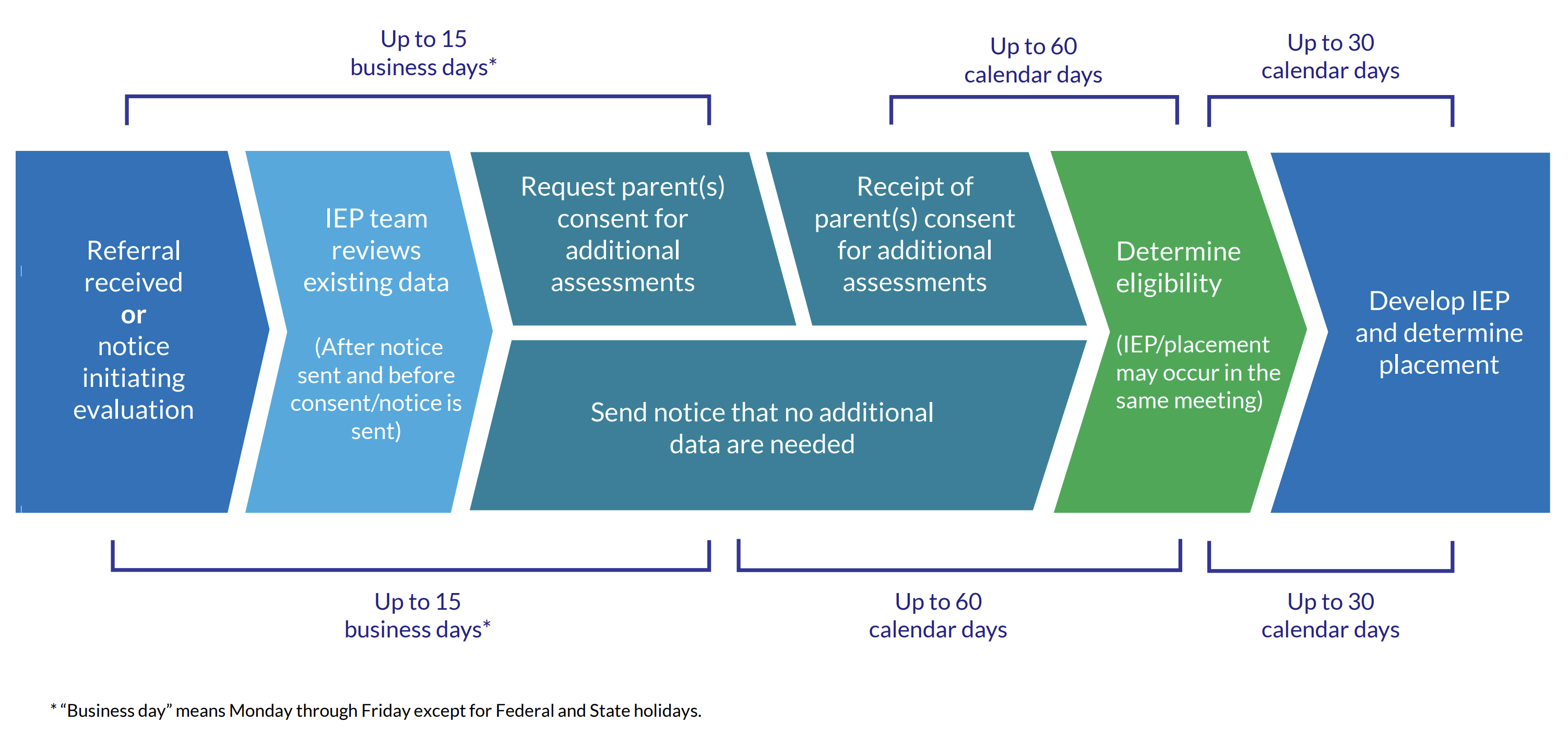Preeligibility for Special Education Services
 Preparing to Learn
Preparing to Learn
Preeligibility for Special Education Services
Before discussing the process for students to receive special education services, complete the assessment below to check what you already know, what you need to unlearn, and what you might be interested in exploring further.
In the United States during the 2021-2022 school year, there were 7.3 million students with disabilities, or 15% of the national public school enrollment (Pew Research Center). And this number continues to increase year after year. As a K-12 public school educator, you will surely educate students with disabilities who benefit from Individualized Education Programs (IEP), but not all of your students with disabilities will have been diagnosed. As a teacher, staying aware of your students’ academic and developmental progress helps you support them in ways that best align with their needs.
The literacy organization Reading Rockets documented 10 steps in the special education process, making it clear what the process looks like for students who need special education services. The accordion below lists these 10 steps. As an educator, understanding these steps helps you proactively approach the process to ensure that students who need special education services receive them.
10 Steps in the Special Education Process (Reading Rockets)
The Prereferral Process for Special Education
Students who struggle often exhibit signs that indicate they need extra support. As a teacher, when you are aware of your students and their progress, you are better able to provide any necessary additional support. Some signs that a student may need additional educational services include:
- Difficulty with reading and/or writing
- Problems with math
- Poor memory
- Problems paying attention
- Trouble following directions
- Difficulty with fine or gross motor skills
- Trouble telling time
- Problems staying organized (Learning Disabilities Association of America, as cited in Eunice Kennedy Shriver National Institute of Child Health and Human Development)
When a student shows signs of struggling and possible need for additional educational support, educators must follow steps to ensure timely interventions.
During the pre-referral process, school personnel work together while keeping parents apprised to try and resolve problems informally assessed within the classroom. The prereferral intervention helps ensure that students receive reasonable accommodations before initiating a formal referral for special education. This stage focuses on gathering student information, both interindividual and intraindividual, while providing effective, high-quality instruction and implementing interventions for struggling students. When an intervention begins, frequent progress monitoring is essential to help teachers make instructional decisions.
Two well-recognized prereferral intervention processes offer targeted support to all students: Response to Intervention (RTI) and Multi-Tiered System of Supports (MTSS).
Step 1. Identification for Special Education Services
Response to Intervention (RTI)
As part of the Multi-Tiered System of Supports for students in K-12 public schools and of the “Child Find” process, Response to Intervention (RTI) offers a systematic approach for assessing and monitoring the learning of all students. The Individuals with Disabilities Educational Act ( IDEA) ensures that students with disabilities receive Free Appropriate Public Education (FAPE) ttailored to their individual needs. While schools can use RTI to determine the existence of a learning disability, they also can use RTI as an early intervention system.
The components of RTI include:
- Universal screening
- Progress monitoring
- Multi-level prevention system
- Data-based decision making (4 Essential Components of a Response to Intervention (RTI) Framework)
A multi-tiered, data-driven intervention model, RTI exposes students to several levels or tiers of increasingly intensive instructional intervention. Initially, RTI calls for delivery of the core curriculum to all students; then, it provides modifications of the curriculum to learners who fail to make adequate progress, while offering even more intensive levels of support to students whose struggles persist. Bayat, Mindes, and Covitt (2010) describe this three-tier approach as follows:
Tier 1. At the first tier, screening of all students occurs, followed by exposure to whole-group, high-quality research-based instruction and progress monitoring.
Tier 2. Children who still have difficulty following the implementation of an evidence-based curriculum receive more intensive support and services.
Tier 3. Pupils who continue to demonstrate a lack of progress receive individualized and highly intensive services beyond those offered in tier 2. A specialized instructor, such as a reading specialist or special education teacher, typically handles their 3 instruction.
This video, Response to Intervention: A Tiered Approach to Instructing All Students, explains the process further.
Multi-Tiered System of Supports (MTSS)
The framework of the Multi-Tiered System of Supports (MTSS) guides RTI. Both offer multi-tiered interventions featuring a continuum of services that involve increasingly intensive interventions based on a student’s documented need. While RTI focuses on students’ academic needs, MTSS takes a more comprehensive approach by addressing the student’s academic, social-emotional, and behavioral needs.
Referral
After RTI and MTSS interventions prove unsuccessful, or through child-find, the next step involves a referral, a formal request to evaluate a student to determine eligibility for special education services. Often, this process begins with a general education teacher who expresses concerns about a student’s academic achievement or social or behavioral problems. A referral may be initiated in certain cases because of a student’s cultural or linguistic background or low teacher expectations. Documentation of prereferral intervention strategies plays an important role in initiating a referral.
Documentation for a referral includes student test scores, work samples, RTI or MTSS intervention data, and behavioral observation and checklist data. This information helps create a comprehensive picture of the student and the concerns that need addressing. The school’s multidisciplinary team, child study committee, or special services team (this group may go by other names) review the referral. The committee includes teachers, school psychologists, social workers, and special education teachers. The team reviews the referral and all accompanying documentation to decide on the need for a full assessment. If the team proceeds with a full assessment recommendation, the school sends a written request for evaluation permission to the parent or guardian. To proceed with a comprehensive assessment, the school must obtain permission from the parent or guardian.
Timeline from the Point of Referral to IEP Development
Illustrated below and further explained in detail throughout this module, an explicit timeline helps ensure that students receive special education services in a timely manner.

Step 2: Evaluation
The comprehensive assessment begins once the school receives written permission from the student’s parent or guardian. The school uses the data gathered from the comprehensive assessment to determine student eligibility for special education services. A time-sensitive timeline must be followed: The comprehensive assessment must be completed within 30 school days after receiving written permission from the student’s parent or guardian. The assessments for special education evaluation also must meet certain psychometric criteria, with reliability and validity as the most important.
A reliable measure will likely produce the same results in measuring what it is intended to measure. A valid measure measures what was intended (construct validity), corresponds well to other valid measures (concurrent validity), and predicts with accuracy likely student performance on an accountability measure (predictive validity).
A complete comprehensive assessment typically includes:
- Curriculum-based assessments (CBAs) that measure a student’s progress in teacher-delivered content.
- Norm-referenced tests, a standardized measurement that compares a student’s performance to peers of the same age or grade.
- Criterion-referenced tests that measure specific performance or content standards on a scale from basic to proficient.
- Intelligence scales (also called IQ tests) that measure a student’s overall cognitive ability.
- Academic achievement tests to understand the student’s present level of academic performance in subjects such as reading, math, or writing.
 Critical Perspective
Critical Perspective
Understanding the Special Education Process from Multiple Perspectives
Your role in your student’s Individualized Education Program (IEP) will determine your involvement and perspective in the process. Knowing that each person brings a unique perspective to this process is important. Below, a list of resources explore various perspectives in the IEP process. Review the following sources and consider the intended audience.
- Understanding the Differences Between IDEA and Section 504
- A Step-By-Step Guide to the IEP Process
- Content of the IEP
- U.S. Department of Education: A Guide to the Individualized Education Program
- Individualized Education Programs (IEPs): Tips for Teachers
- 4 Ways Students Can Take an Active Role in Their IEP Meetings
- Maximizing Parental Involvement in Developing the IEP
Step 3: Eligibility Decision
After students complete a comprehensive assessment, the school determines their eligibility to receive special education services, which varies from state to state. The Individuals with Disabilities Education Act recognizes 13 categorical disability areas that qualify students for special education services.
13 Disability Categories
After completing a comprehensive assessment, the student and parent or guardian meet with the multidisciplinary team to discuss the results. If the meeting takes place 30 days or more following parental consent, the student’s parent or guardian must be provided with the complete assessment before the meeting; otherwise, if the meeting occurs within 30 days of parental consent, the parent or guardian must be provided the complete assessment at the time of the meeting.
Step 4: Eligibility and Plan of Action
Following the comprehensive assessment, the school decides student eligibility for special education services, as outlined in step three. If the student meets the eligibility requirements for any of the 13 disability categories outlined by the Individuals with Disabilities Education Act, the school develops a plan of action to help support the student.
The action plan could be an Individualized Education Program (IEP) for school-age students or an Individualized Family Service Plan (IFSP) for students three years old or younger. Those who teach in the context of K-12 education most likely will deal with IEPs.The student’s support team develops both plans in partnership with the student’s parent or guardian. The IEP must completed for the student to receive special education services.
 Knowledge Check
Knowledge Check
Preeligibility for Special Education Services
References
4 Essential Components of a Response to Intervention (RTI) Framework
10 Steps in the Special Education Process
Bayat, M., Mindes, G., & Covitt, S. (2010). What does RTI (response to intervention) look like in preschool? Early Childhood Education Journal, 37(6), 493–500.
Eunice Kennedy Shriver National Institute of Child Health and Human Development
Schaeffer, K. (2023, July 24). What federal education data shows about students with disabilities in the U.S. Pew Research Center. https://www.pewresearch.org/short-reads/2023/07/24/what-federal-education-data-shows-about-students-with-disabilities-in-the-us/
the process of requesting an evaluation for a student who is suspected of having a disability. A referral is official and must be in written form. Once it is made, timelines and procedural safeguards ensue.
an assessment used to determine whether students are making adequate progress and to determine whether instruction needs to be adjusted.
is a multi-tiered instructional framework [and] schoolwide approach that addresses the needs of all students, including struggling learners and students with disabilities, and integrates assessment and intervention within a multi-level instructional and behavioral system to maximize student achievement and reduce problem behaviors
is a school-wide approach that addresses the needs of all students, including struggling learners and students with disabilities, and integrates assessment and intervention within a multi-level instructional and behavioral system to maximize student achievement and reduce problem behaviors
Individuals with Disabilities Education Act is a piece of American legislation that ensures students with a disability are provided with a free appropriate public education that is tailored to their individual needs.
Free Appropriate Public Education
as part of IDEA, the State must have in effect policies and procedures to ensure that—
(i) All children with disabilities residing in the State, including children with disabilities who are homeless children or are wards of the State, and children with disabilities attending private schools, regardless of the severity of their disability, and who are in need of special education and related services, are identified, located, and evaluated; and
(ii) A practical method is developed and implemented to determine which children are currently receiving needed special education and related services
the involvement of two or more separate disciplines or professions and with respect to evaluation of the child in and assessments of the child and family in may include one individual who is qualified in more than one discipline or profession; and the IFSP team and must include the involvement of the parent(s)
the trustworthiness or consistency of a measure, that is, the degree to which a test or other measurement instrument is free of random error, yielding the same results across multiple applications to the same sample.
how accurately a method measures what it is intended to measure.
is the extent to which a measure accurately assesses the construct or latent attribute that it is intended to measure.
measures the extent to which a measurement is confirmed by a related measurement. It is a type of criterion-related validity that compares the test results to observations or measurements from other tests, surveys, or assessments
evidence that a test score or other measurement correlates with a variable that can only be assessed at some point after the test has been administered or the measurement made. For example, the predictive validity of a test designed to predict the onset of a disease would be strong if high test scores were associated with individuals who later developed that disease.
